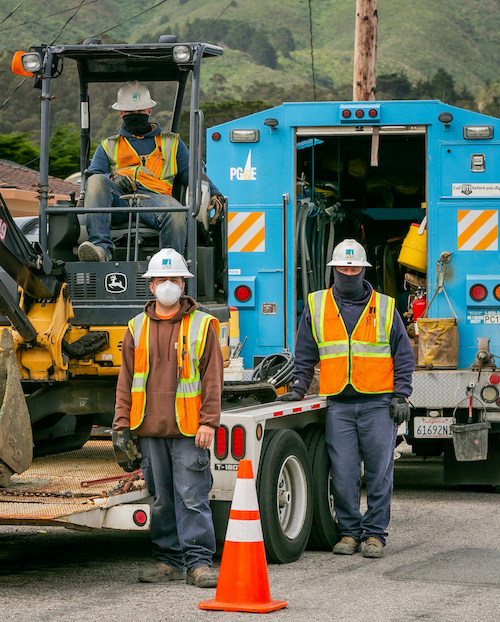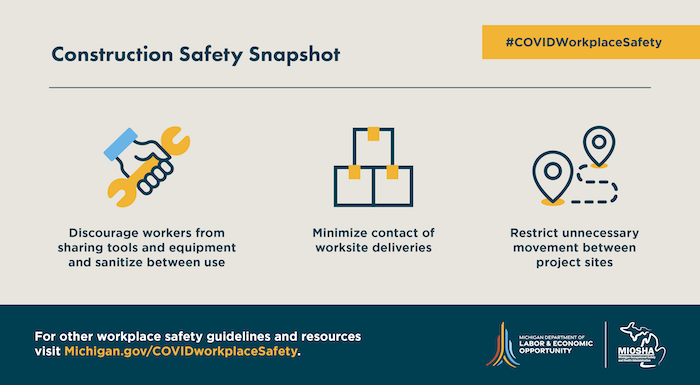Labor activists and public officials are making strides at the state level to reduce workers’ risk of exposure to COVID-19, piecemeal but vital efforts in the absence of a national game plan nine months into the pandemic.

|
States led by pro-worker governors and lawmakers are working to fill in gaps left by federal OSHA’s response to the COVID-19 crisis. With input from labor, they are issuing rules and policies requiring employers to take specific steps to protect workers. In California, members of Vacaville Local 1245, demonstrate proper mask use on the job.
Photo by John Storey, courtesy Local 1245.
|
Their actions have led to virus-specific requirements on employers in at least 14 states through emergency orders and guidelines that offset the Trump administration’s refusal to issue a federal standard.
By default, the virus falls under the Occupational Safety and Health Administration’s general duty clause, stating that employers must maintain a work environment "free from recognized hazards that are causing or are likely to cause death or serious physical harm.”
Using the broadly interpreted language to crack down on COVID-19 violations is challenging at best, and often futile.
“Like trying to perform surgery with a butter knife,” is how Sean Egan puts it, and he would know.
A journeyman wireman, lawyer and former business manager of Muskegon, Mich., Local 275, Egan was appointed by Gov. Gretchen Whitmer to manage Michigan’s battle plan for COVID-19 workplace safety.
He helped develop an emergency standard that went into effect Oct. 14 as the state’s infection rate was rising, rules that even won support from business associations for their specificity.
They understood that an enforceable standard evens the playing field and helps them stay open, Egan said, “because not all employers would take precautions on their own, and that spreads the virus.”
OSHA’s ambiguous clause isn’t the only federal barrier to safeguarding workers in the COVID-19 era.
Years of budget and staff cuts, and more recently political neglect, have created an unmanageable backlog at the agency, impairing its capacity, and will, to investigate and penalize law-breaking employers.
“We’ve seriously undervalued workplace safety in this country for so long,” Egan said, summing up both cause and effect.
In Iowa, Dubuque Local 704 Business Manager Tom Townsend said state and federal inspectors were stretched to the breaking point long before the virus first raced through meatpacking plants in April.
“They’d be inspecting for 20 years here just to inspect every facility right now, without any new job sites,” he said. “You have to tell them that someone’s going to die, and then maybe they show up in a couple of days.”
He doesn’t blame the inspectors. “It’s not their fault,” Townsend said. “Those guys are doing the best they can.”
An October report from the National Employment Law Project illustrates what else is falling through OSHA’s cracks in the wake of the pandemic.
Between March and early August, NELP researchers found that 1,744 workers formally complained of retaliation for reporting unsafe working conditions related to COVID-19.
Just 348 of the complaints were forwarded to investigators and more than half of those were never touched. Ultimately, only 35 of the original complaints were resolved, but OSHA hasn’t revealed whether outcomes favored employees or employer.
Either way, researchers said, “resolving a mere 2% of OSHA retaliation complaints in six months is a dismal record under any circumstances, but especially egregious during a pandemic.”
This week, the United States surpassed 250,000 deaths from COVID-19 and is on the verge of exceeding 12 million positive tests. Known infections are soaring by nearly 200,000 a day and 80,000 people are hospitalized, the most since the pandemic began.

|
|
Social media graphics are among a wealth of online tools, worksheets, data, webinars and other information provided by Michigan’s Department of Labor and Economic Opportunity, where former Muskegon Local 275 Business Manager Sean Egan heads the state’s comprehensive program to protect workers from COVID-19 exposure.
|
Oregon has had more success than many states in managing the virus, but like the nation at large, its infection rate rose sharply this fall.
The state AFL-CIO says workers are bearing the brunt of it, as they have all along, and elected leaders aren’t doing nearly enough about it.
“Seven grueling months into the pandemic, Oregon workers are still without a clearly defined set of rules to prevent the spread of this deadly virus in workplaces,” federation president and Portland Local 48 member Graham Trainor said in a column published by The Oregonian.
He cited two dozen deaths in Oregon and more than 5,000 infections linked to exposure at work.
“Working Oregonians need swift action, because without the assurance of safety we cannot truly reopen our economy and start to recover,” Trainor wrote.
In Michigan’s worker-safety apparatus, Egan wears multiple hats. In addition to his COVID-19 duties, he is deputy director for Labor in the state’s Labor and Economic Opportunity Department, including oversight of the occupational safety and health agency known as MIOSHA.
Prior to the standard issued in October, MIOSHA used the OSHA general duty clause to apply the virus-related emergency orders that Whitmer signed between April and September.
When the state Supreme Court struck down the orders Oct. 2 in a partisan ruling that said the governor exceeded her authority, Egan’s team flew into action. Twelve days later, under its own authority, MIOSHA issued the standard.
Tailored for different types of businesses, it spells out rules for masks and other personal protective equipment, social distancing, hand-washing, sanitation, minimum days that sick or exposed workers must stay home, record-keeping, training and more.
Similar language is the foundation of safeguards adopted in other worker-friendly states. In addition to Michigan, NELP put 13 other states on that list — California, Illinois, Kentucky, Massachusetts, Minnesota, Nevada, New Jersey, New York, Oregon, Pennsylvania, Rhode Island, Virginia, Washington.
Virginia was the first state, and only other so far, to issue an emergency standard. Like Michigan’s it expires after six months but can be renewed.
With input from unions, Virginia’s safety and health codes board passed the standard 9-2 in June over the strident objections of business groups.
“Workers should not have to sacrifice their health and safety to earn a living, especially during an ongoing global pandemic,” Gov. Ralph Northam said. “In the face of federal inaction, Virginia has stepped up to protect workers.”
Workers in many red states aren’t so lucky. In Iowa, Townsend decried the state’s abject failure to combat the virus’s spread.
He pointed to Gov. Kim Reynolds’ threat to strip unemployment benefits from fearful workers who failed to return to meatpacking plants that swiftly reopened last spring, flouting the warnings of medical experts.
State leaders’ defiance continued even when Iowa’s infection rate rocketed to twice the U.S. average as the pandemic’s autumn surge gripped the nation.
“It’s been a joke the way that Iowa has handled COVID,” Townsend said.
But no battle is too steep for labor to fight. Townsend is proud that one of the people on the front lines is former Local 704 organizer and executive board member Pete Hird, now secretary-treasurer of the Iowa AFL-CIO.
“He’s such a voice for those who don’t have a voice,” Townsend said.
A journeyman wireman, Hird was appointed and then elected to his post last spring, just as COVID-19 was taking the country hostage.
He has been working with unions, social justice allies and legal groups on strategies to push the state to live up to its obligation to workers.
“It’s always been more about the economy here than the people who keep the economy moving,” Hird said.
OSHA’s regulatory authority varies widely across the country. In Iowa most power rests with state officials.
On paper, at least, “that means we can create standards that are stronger than the federal guidelines,” Hird said. “Maybe even standards like Virginia’s and Michigan’s.”
It’s a sky-high bar, but he’s driven by the reality that a majority of Iowans have no choice but to get up every day and go to work outside their homes, no matter the risk.
“You think about people working in plants or grocery stores,” Hird said. “They’re facing the disease every day. There’s no mask mandate, nothing enforceable. Knowing that they could be bringing the virus home to their families is terrifying for them.”